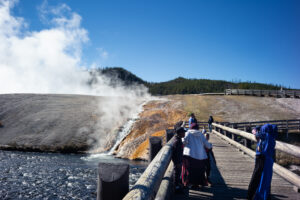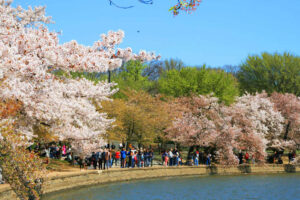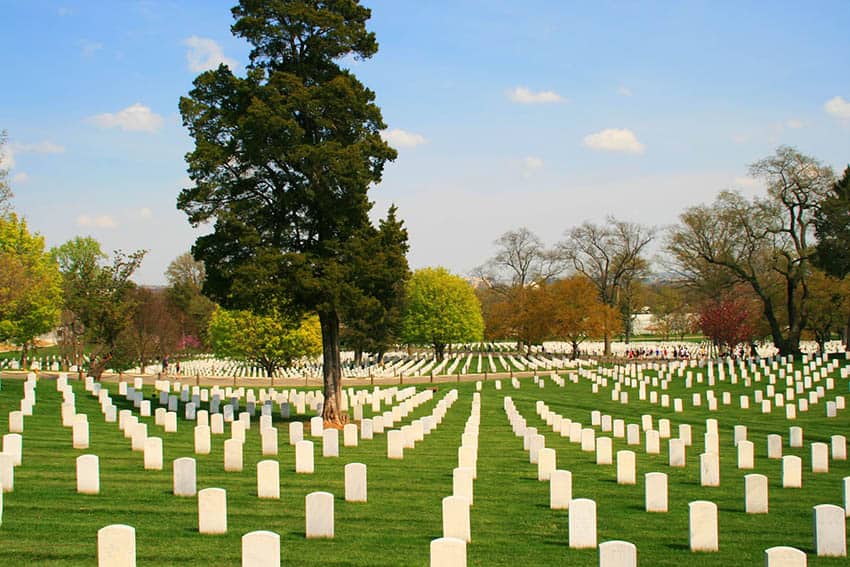
Honoring Those Who Served at Arlington National Cemetery
By Frank Hosek

Each weekday, Arlington National Cemetery conducts 20-25 funerals and receives another 35 requests for services.
When visiting the wooded land on the west side of the Potomac River across from Washington, DC, its history and famous occupants can make you forget that above all else Arlington is hallowed ground.
With flowering tulips and budding trees of early spring as a back-drop, we entered the grounds of Arlington on an unusually warm April afternoon.
The Welcome Center, located by the main cemetery entrance, houses several vignettes describing the inner workings of Arlington including a statue of Taps being blown.
You are allowed to walk the grounds, however at 639 acres the cemetery is expansive.

So we opted for the tram tour of Arlington National Cemetery with its hop on/hop off option which allowed you to disembark at various stops and explore on your own.
As the tram slowly moved through the verdant, rolling bucolic surroundings you cannot ignore the most famed images of Arlington; the small rectangular white marble markers that spread across the grounds in tight, uniform formation.
These most recognizable headstones are issued by the Department of Veteran Affairs, free to service members for their service to the country.
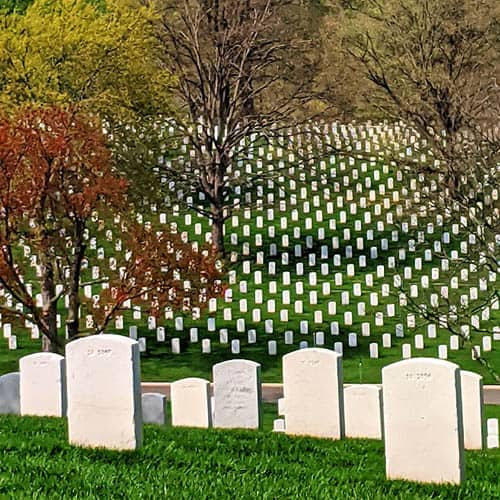
Today, they stand at parade-rest as if awaiting TAPS.
One of those simple white marble headstones honors Major Audie Murphy. Before he became a Hollywood movie star, he was one of the most decorated American combat soldiers of World War II.
Families can opt to pay for more elaborate markers and you do see these noticeably different markers liberally scattered throughout.
Journalist Nicholas Proffit who was formally on the burial detail at Arlington National Cemetery, characterized the numerous memorials and gravestones as “gardens of stone”.
One of the most visited grave sites is that of John F. Kennedy who became the second U.S. President to be buried there (William H. Taft was the first).
Eleven days prior to Kennedy’s assassination, he visited Arlington for the 1963 Veterans Day services.
The President spoke to a National Park Service ranger who later recalled the President saying the view was so magnificent he wished he could stay forever.
President Kennedy lays at rest just below the Arlington House overlooking the view he loved.
Covered in Cape Cod granite with simple black slate markers, the President, two of his children and his wife, Jacqueline Kennedy Onassis, lie beneath.
At the head of his grave, the iconic Eternal Flame burns as a symbol of hope.
As we walked up to the site, a woman turned away, brushing tears away from her eyes. I understood the emotional impact.
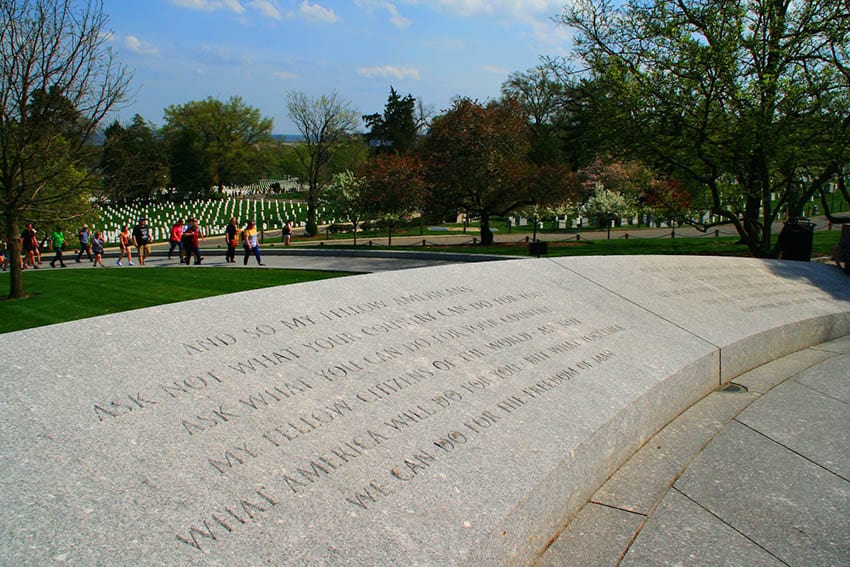
My first recollections of President John F. Kennedy are of his televised funeral procession. His flag-draped coffin carried upon a horse-drawn caisson made a powerful impression on my young consciousness. For this reason, our first stop was met by myself with mixed emotions.
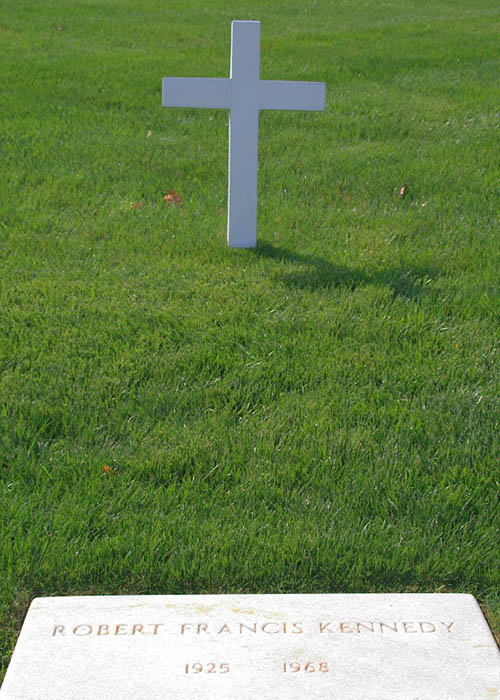
Nearby, Robert Kennedy is also buried. Bowing to his previously expressed thoughts, his grave is adorned with only a cross and a flat marker.
As we stood before his grave, its humble markers imparted a loss far greater than any monument.
While we awaited the tram, we wandered the area discovering, among other sites, Ruth Bader Ginsburg’s gravesite. She is one of 14 justices interred at Arlington.
Our next stop was the Memorial Amphitheater and the Tomb of the Unknown Soldier. The Tomb of the Unknown Soldier is one of Arlington’s most revered memorials.
The neoclassical, white marble sarcophagus stands atop a hill overlooking Washington, D.C.
Since 1921, it has provided a final resting place for one of America’s unidentified World War I service members, and Unknowns from later wars were added in 1958 and 1984.
As we stood in the plaza of the Memorial Amphitheater where the tomb rests, I read the inscription etched upon the sarcophagus, “Here rests in honored glory an American soldier known but to God.”
A guard stands sentinel over the Tomb of the Unknown Soldier 24 hours a day, 365 days a year, in any weather.
The Changing of the Guard takes place as the sentry is relieved every hour on the hour between October 1 to March 31 and every half hour April 1 to September 30.
The 3rd U.S. Infantry Regiment, traditionally known as “The Old Guard,” provides the ceremonial unit.
Dressed in impeccable crisp, dark blue uniforms, they present a dignified ballet of the highest discipline.
As we joined the crowd standing in rapt silence, the guard performed the most moving ceremony of the uppermost respect. With practiced deliberation and a steely focus, the sergeant of guards conducted a rigorous inspection of the relief guard.
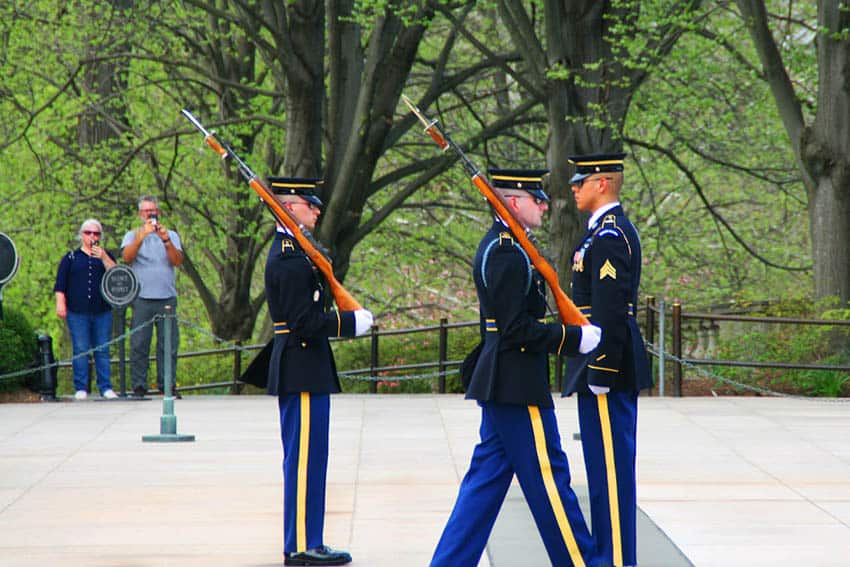
Then, as the exchange of guards is made, all three saluted the Unknowns with the sergeant of guards and relieved guard exiting in stoic unison.
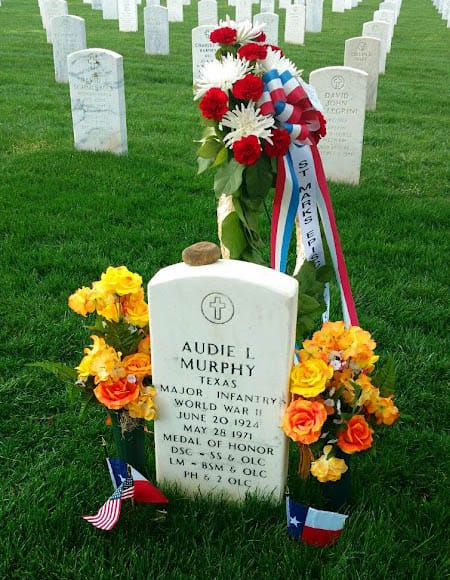
Even after the change had been orchestrated, the crowd lingered in reverent silence and watched the sentinel.
Twenty-one measured, rhythmic steps, stop, turn with a click of the heels, and face east for a count of 21 seconds.
Turn, again with a click of the heels, face north for a count of 21 seconds, and execute a sharp “shoulder-arms” motion in order to place his rifle on his shoulder closest to the enthralled but silent gallery.
This is signifying that he stands between the Tomb and any possible threat and then proceeded for precisely 21 steps.
Twenty-One Steps
Twenty-one steps, 21 seconds, 21 seconds, twenty-one steps.
The number 21 symbolizes the highest military honor that can be bestowed, the 21-gun salute.
Afterward, we explored the USS Maine Memorial. Its explosion was the impetus of the Spanish-American war. Its salvaged mast stands sentinel over the remains of 230 service members.
A few yards away we encountered the Space Shuttle Challenger Memorial where the cremated remains of the seven Challenger astronauts were buried.
Nearby were the memorials to the Space Shuttle Columbia, and the Iran Rescue Mission Monument both honoring those who had been lost.
Throughout the cemetery, there are statues and monuments honoring the many who had given the last full measure of devotion.

Arlington has a way of stirring memories that had long been pushed aside.

Our final stop was the Arlington House, a Greek Revival-style mansion with 8 colossal columns. The history of Arlington House is the history of Arlington Cemetery.
Built by George Washington Parke Custis, the adopted grandson of our first president, George Washington, it was inherited by Mary Custis upon her father’s death.
Arlington was her and her husband’s home at the beginning of the Civil War. Mary Custis’ husband was Robert E. Lee.
A career officer with the United States Army, he had resigned his commission to follow Virginia into the Confederacy and eventually became the commander-in-chief of its armies.
The Union Takes Control
The Union took control of the estate in 1861. Gen. Montgomery C. Meigs, the head of the Quartermaster Corps, was tasked with locating grounds for the many deaths brought on by the war.
By the 3rd year, Meigs cast about for a new graveyard to accommodate the rising tide of bodies. His eye fell upon Arlington.
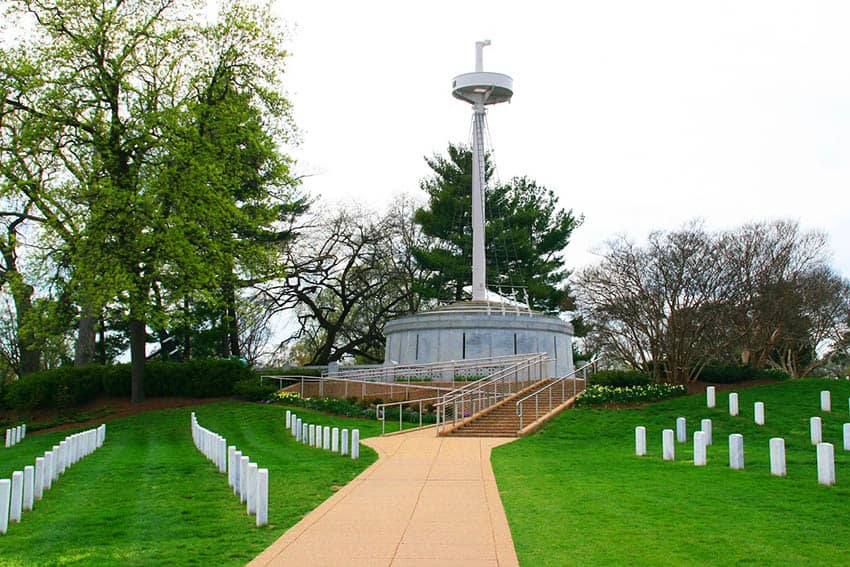
To ensure that the Lees never returned to their ancestral home, he decided to create a devoted vault for the remains of over 2 thousand unknown soldiers in Mrs. Lee’s rose garden. Upon the tomb he raised a sarcophagus in their honor.
Arlington Finalized in 1883
This was the first memorial at Arlington to be dedicated to soldiers who had died in battle and whose remains could not be identified. The beginnings of a National Cemetery were in place, but, not until after years of wrangling in the courts by the heirs was it finalized in 1883.
Today, this pedigreed home stands high above the broad, green pastoral setting overlooking all of Washington DC. From left to right we could see the Lincoln Memorial, the Washington Monument, the Capitol Dome, and the Jefferson Memorial.
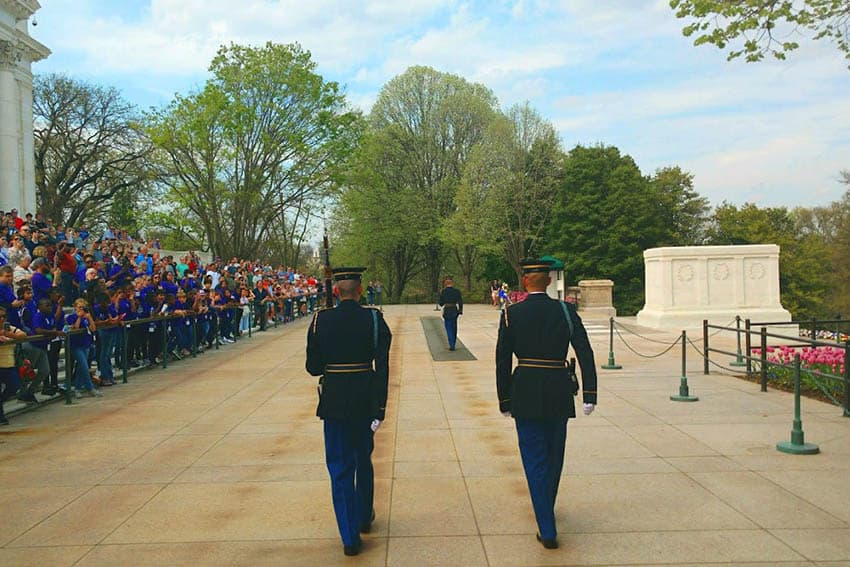
Before we left, I walked over to the Tomb of the Civil War Unknowns. The side of the memorial features the following inscription:

BENEATH THIS STONE
REPOSE THE BONES OF TWO THOUSAND HUNDRED AND ELEVEN UNKNOWN SOLDIERS
GATHERED AFTER THE WAR
FROM THE FIELDS OF BULL RUN, AND THE ROUTE TO THE RAPPAHANNOCK,
THEIR REMAINS COULD NOT BE IDENTIFIED. BUT THEIR NAMES AND DEATHS ARE
RECORDED IN THE ARCHIVES OF THEIR COUNTRY, AND ITS GRATEFUL CITIZENS
HONOR THEM AS OF THEIR NOBLE ARMY OF MARTYRS. MAY THEY REST IN PEACE.
SEPTEMBER. A. D. 1866
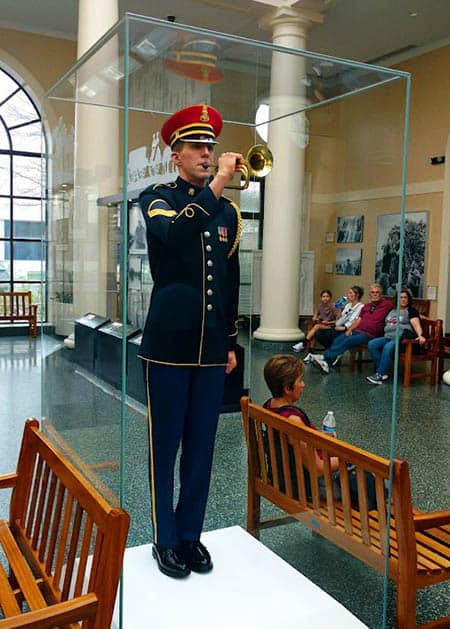
The 639 acres that comprise Arlington National Cemetery are a beautiful and wonderful final resting place and are a fitting honor to not just the many Unknowns but also to the over 400,000 veterans and their families that are buried there.
We had come to Arlington National Cemetery as tourists. It is a place that deserves more than that.
We ended our day in reverence and silent respect for the hundreds of thousands who lived, served and honored our country and who now lie in quiet repose overlooking the nation’s capital.
Arlington Details
There is no entry fee to visit Arlington National Cemetery. However, there are parking fees if you use the parking garage.
There is a fee for the tour. Adults-$19.50, Children-$10.75, Seniors-$15.00. Uniformed Military are free
website
 Frank Hosek is an Illinois-based Director of Human Resources who revels in traveling with his wife, Kathy. He enjoys discovering new experiences, meeting the people that make those experiences enjoyable, and sharing their adventures. He is a freelance writer for newspapers, magazines, and travel websites.
Frank Hosek is an Illinois-based Director of Human Resources who revels in traveling with his wife, Kathy. He enjoys discovering new experiences, meeting the people that make those experiences enjoyable, and sharing their adventures. He is a freelance writer for newspapers, magazines, and travel websites.
- Mongolia, the Land of Eternal Blue Sky - April 20, 2024
- These 9 U.S. National Parks Require Reservations in 2024 - April 17, 2024
- Take a Hike in Olympic National Park - April 17, 2024


